ICND1 – Switch Questions
[am4show have=’p2;’]
Premium Member: You can test your knowledge with these questions first via this link.
[/am4show]
Question 1
[am4show have=’p2;’]A switch has 48 ports and 4 VLANs. How many collision and broadcast domains exist on the switch?
A. 4, 48
B. 48, 4
C. 48, 1
D. 1, 48
E. 4, 1
Answer: B[/am4show]
Explanation
Each port on a switch is a collision domain while each VLAN is a broadcast domain because broadcast is only forwarded within that VLAN so we have 48 collision domains and 4 broadcast domains on this switch (if all ports are used).
Question 2
[am4show have=’p2;’]A switch receives a frame on one of its ports. There is no entry in the MAC address table for the destination MAC address. What will the switch do with the frame?
A. drop the frame
B. forward it out of all ports except the one that received it
C. forward it out of all ports
D. store it until it learns the correct port
Answer: B[/am4show]
Question 3
[am4show have=’p2;’]Which address type does a switch use to make selective forwarding decisions?
A. source IP address
B. destination IP address
C. source and destination IP address
D. source MAC address
E. destination MAC address
Answer: E[/am4show]
Explanation
When a switch receives a frame, it first checks for the destination MAC address and tries to find a matching entry in its MAC address table. If found, the switch then forwards that frame on the corresponding port associated with that MAC address. If no entry is found, the switch will flood that frame out of all (active) ports except the port that sent it.
Question 4
[am4show have=’p2;’]Which two characteristics apply to Layer 2 switches? (Choose two)
A. increases the number of collision domains
B. decreases the number of collision domains
C. implements VLAN
D decreases the number of broadcast domains
E. uses the IP address to make decisions for forwarding data packets
Answer: A C[/am4show]
Question 5
[am4show have=’p2;’]What is the purpose of assigning an IP address to a switch?
A. provides local hosts with a default gateway address
B. allows remote management of the switch
C. allows the switch to respond to ARP requests between two hosts
D. ensures that hosts on the same LAN can communicate with each other
Answer: B[/am4show]
Question 6
[am4show have=’p2;’]How does a switch differ from a hub?
A. A switch does not induce any latency into the frame transfer time.
B. A switch tracks MAC addresses of directly-connected devices.
C. A switch operates at a lower, more efficient layer of the OSI model.
D. A switch decreases the number of broadcast domains.
E. A switch decreases the number of collision domains.
Answer: B[/am4show]
Explanation
A hub is not as “intelligent” as a switch because a hub does not try to remember anything passing to it. It just floods out all the ports (except the one that sent it) when it receives a frame.
Question 7
[am4show have=’p2;’]Refer to the exhibit. The ports that are shown are the only active ports on the switch. The MAC address table is shown in its entirety. The Ethernet frame that is shown arrives at the switch. What two operations will the switch perform when it receives this frame? (Choose two)
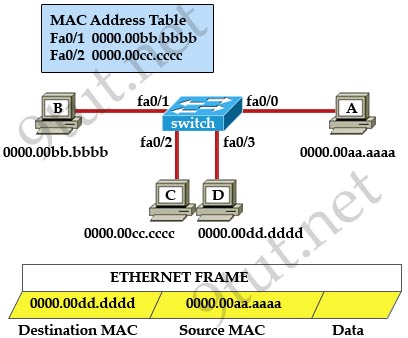
A. The MAC address of 0000.00aa.aaaa will be added to the MAC address table.
B. The MAC address of 0000.00dd.dddd will be added to the MAC address table.
C. The frame will be forwarded out port fa0/3 only.
D. The frame will be forwarded out fa0/1, fa0/2, and fa0/3.
E. The frame will be forwarded out all the active ports.
Answer: A D[/am4show]
Explanation
When a switch receives a frame, it first checks for the destination MAC address and tries to find a matching entry in its MAC address table. If found, the switch then forwards that frame on the corresponding port associated with that MAC address. If no entry is found, the switch will flood that frame out of all active ports except the port that sent it. In this case, the destination MAC address 0000.00dd.dddd has not been in the MAC address table so the switch will flood the frame out all of its ports except fa0/0 (the port that it received the frame) -> D is correct.
Also, the switch learns that the MAC address 0000.00aa.aaaa is received on fa0/0 -> the switch adds 0000.00aa.aaaa and its corresponding port fa0/0 to the MAC address table -> A is correct.
Question 8
[am4show have=’p2;’]Refer to the exhibit. The MAC address table is shown in its entirety. The Ethernet frame that is shown arrives at the switch. What two operations will the switch perform when it receives this frame? (Choose two)
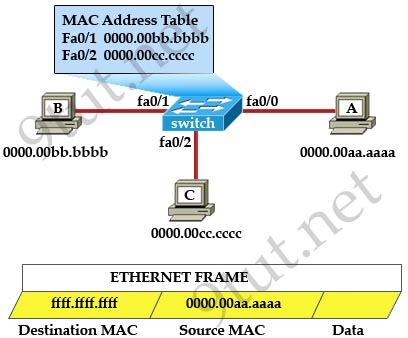
A. The switch will not forward a frame with this destination MAC address.
B. The MAC address of 0000.00aa.aaaa will be added to the MAC Address Table.
C. The MAC address of ffff.ffff.ffff will be added to the MAC address table.
D. The frame will be forwarded out all active switch ports except for port fa0/0.
E. The frame will be forwarded out fa0/0 and fa0/1 only.
F. The frame will be forwarded out all the ports on the switch.
Answer: B D[/am4show]
Explanation
The destination MAC address is ffff.ffff.ffff so this is a broadcast frame so the switch will forward the frame out all active switch ports except for port fa0/0.
Question 9
[am4show have=’p2;’]Refer to the exhibit. The exhibit is showing the topology and the MAC address table. Host A sends a data frame to host D. What will the switch do when it receives the frame from host A?

A. The switch will add the source address and port to the MAC address table and forward the frame to host D.
B. The switch will discard the frame and send an error message back to host A.
C. The switch will flood the frame out of all ports except for port Fa0/3.
D. The switch will add the destination address of the frame to the MAC address table and forward the frame to host D.
Answer: A[/am4show]
Explanation
In this case the destination MAC address has been learned so the switch just forwards the frame to the corresponding port. It also learn that the source MAC address of host A has not been existed in the MAC address table so it will add it (and port fa0/3) to its MAC address table.
Question 10
[am4show have=’p2;’]Refer to the topology and switching table shown in the graphic. Host B sends a frame to Host C. What will the switch do with the frame?
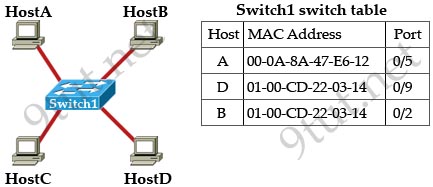
A. drop the frame
B. send the frame out all ports except port 0/2
C. return the frame to Host B
D. send an ARP request for Host C
E. send an ICMP Host Unreachable message to Host B
F. record the destination MAC address in the switching table and send the frame directly to Host C
Answer: B[/am4show]
Question 11
[am4show have=’p2;’]Refer to the exhibit. SwitchA receives the frame with the addressing shown in the exhibit. According to the command output also shown in the exhibit, how will SwitchA handle this frame?
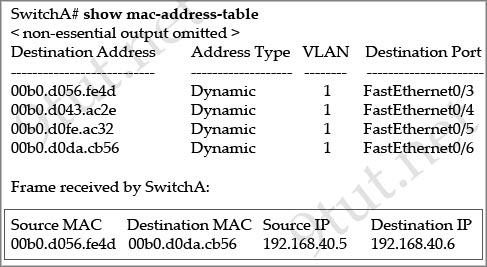
A. It will drop the frame.
B. It will forward the frame out port Fa0/6 only.
C. It will forward the frame out port Fa0/3 only.
D. It will flood the frame out all ports.
E. It will flood the frame out all ports except Fa0/3.
Answer: B[/am4show]
Question 12
[am4show have=’p2;’]Refer to the exhibit. An administrator replaced the 10/100 Mb NIC in a desktop PC with a 1 Gb NIC and now the PC will not connect to the network. The administrator began troubleshooting on the switch. Using the switch output shown, what is the cause of the problem?
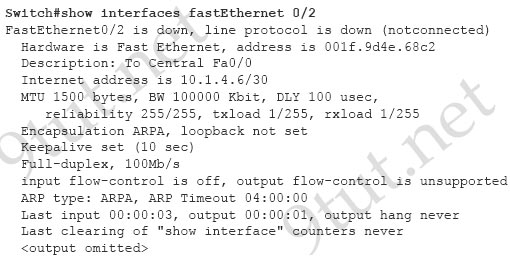
A. Speed is set to 100Mb/s.
B. Input flow control is off.
C. Encapsulation is set to ARPA.
D. The port is administratively down.
E. The counters have never been cleared.
Answer: A[/am4show]
Question 13
[am4show have=’p2;’]The system LED is amber on a Cisco Catalyst 2950 series switch. What does this indicate?
A. The system is not powered up.
B. The system is powered up and operational.
C. The system is malfunctioning.
D. The system is forwarding traffic.
E. The system is sensing excessive collisions.
Answer: C[/am4show]
Explanation
The system LED shows whether the system is receiving power and functioning properly. Below lists the LED colors and meanings:
| Color | System Status |
| Off | System is not powered up. |
| Green | System is operating normally. |
| Amber | System is receiving power but is not functioning properly. |
(Reference: http://www.cisco.com/en/US/docs/switches/lan/catalyst2950/hardware/installation/guide/hgovrev.html)
Question 14
[am4show have=’p2;’]SW-C has just been added to the network shown in the graphic
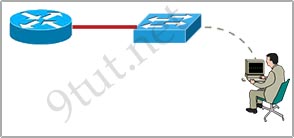
What is the purpose of assigning a default gateway to this switch?
A. allows connectivity to Router B from the switch prompt
B. allows console port connectivity to the switch from Host A
C. allows connectivity to remote network devices from Host B
D. allows the switch to pass traffic between Host A and Host B
Answer: A[/am4show]


answer question 11 is E
Raymon, I disagree.
B is the correct answer because the Switch already has the Destination MAC in its MAC address table.
I agree the router47, the switch is already aware of the Mac Address
I know why Raymon said ans is E for Q11, in pass4sure it is incorrect and the answer is E there, but correct answer is B
Yes Kam, I agree with you,
answer for this question in pass4sure dump from Spike is incorrect (E) although his explanation is correct when we click on “Show Answer” button.
In regards with Question 11, another similar question exists with same Mac address table but, frame received by Switch A has Destination Mac 00b0.d0da.895a.
Question is :
“SwitchA receives the frame with the addressing shown in the exhibit. According to the command output also shown in the exhibit, how will SwitchA handle this frame?”
Answers proposed are :
“A – It will drop the frame
B – It will forward the frame out port Fa0/3 only
C – It will flood the frame out all ports
D – It will flood the frame out all ports except Fa0/3.”
Then, D is the correct answer for this question.
Of course 11 is B. Why do people learn answers by heart and also always trust them? Read the material, learn the material, watch CBT Nuggets etc etc….instead of saying it’s E just because pass4sure says it is. Not trying to be rude, but for the love of God use your brain. We have too many people at work that got their exams just by learning answers, and the result is terrible, since they don’t know sh**!!! 😛
Of course I didn’t pass CCNA by using this site. I’m only here to troll you.
Anyone,
I plan on taking exam next week. What other sims/labs did you get besides the OSPF 6 router?
Thanks in Advance!
Of course the answer for question 11 is B, because the switch know the port of destination mac address
Question 10, b and d is the same thing? ARP request is a broadcast to all but the source.
Randy, I think the point is that switches do not send ARP requests – PCs do.
Question 6 answer B says the switch remembers the MAC of directly connected devices. That is not correct. It remembers the MAC of all devices that can be reached through that port. So, if there is a switch or hub connected to that port, it will remember the MACs of all devices attached to that switch or hub as well as those beyond. If this were not the case, it would not be possible to have more than one switch in a network, as the switch wouldn’t know how to reach anything beyond the next switch.
Randy and fructal,
b and d are not the same thing. Fructal kind of has it right. The pc has already performed an arp request, that’s how he knows what to put as the destination MAC address in the frame. And as he also said, switches do not perform ARP requests. They simply forward a frame out all ports except the receiving port if they do not have an entry in their MAC tables for that specific MAC address. The question asks how will the switch handle the frame, and since the switch has no entry in it’s MAC table for that destination address, it will forward that frame out of all of its active ports except for the port that it received the frame on.
B is correct
Source MAC:
Hello SWITCH A, I have a frame delivery for 00b0.d0da.cb56
SWITCH A:
Let me check my MAC Table here…
AHA! I have a MAC entry here for 0b0.d0da.cb56 already and I will forward the frame out to port FA0/6 only.
NOTE:No need to shout/flood/broadcast to all ports. Hey all ports!(except source port) Do you own this mac address 00b0.d0da.cb56?
Since we have the destination mac address already on the MAC Table, answer is B
I Agree with JoseD…What does switch do…It learns the mac address. If the switch has the entry in mac table..then switch will just forward it to that port, and will not flood all the port.
Shyamal
Yes its B sure 100%, the scenario is the switch getting the frame from port 3 and forward it to port 6 its simple as that, its really disaster if pass4sure did it the wrong answer.
Passed my 100-101 exam today and question 2,3,4,5,7,8 and 9 were there.. all the best
Got 986/1000 Marks, {5/16/2014} 50 Questions, Ospf Sim, Security simlet, and Router and switch Simlet Was also there…..All questions From 9tut. and Examcollections…..Now Heading For Icnd2 And Blogging…..
For Any Help.
Manohar Tn
Website: http://www.techlinko.com
G+ : https://plus.google.com/u/0/+ManoharTN9/
I passed the exam last week, many question from 9tut,as from this chapter were in the exam.
Thnx 9tut 😉
Guys you should get free dumps and many other helping materials from [ http://adf.ly/o7ba3 ]
Its a direct and safe download and the download speed is ultra high.
Also the dumps is super easy to download.
Enjoy.
Thank you Jose D. Your example was awesome.
regarding question 8: Frame will be forwarded to all ports, “Because it’s a broadcast frame”.
I didn’t even know about this thing called broadcast frame, so looked it up.
kuddo’s to the great and complete explanations
For question #1 i think A and B are both correct cause you didn’t specify respectively or not,
for A is 4 broadcast domains because of those 4 Vlans and 48 collision domains and B is viceversa
pls tell me on exam short commands are working or not .. i mean ro#sh
pls tell me on exam short commands are working or not .. i mean ro#sh run ,int fa 0/0 like that pls tell me on 18 i want to take exam …
Can anyone tell me why option “B” is not correct in question 7. Why switch will not add the destination MAC address 0000.00dd.dddd. Does it need the full path to the destination before it add the destination MAC address to the table?
It adds the source MAC, not the destination.
Passed my ICND1 exam this morning, 986/1000. ALL these questions were there!!
Thanks to 9tut…Can’t wait to start ICND2
Good luck…
@Raymon : the Switch is not Lazy like you, why does it have to shout/flood/broadcast to all ports.
Antention all ports!(except source port) Do you own this mac address 00b0.d0da.cb56?
While on the look up table ther’s Destination
And comeon on Networking u don’t memorize answers……ds site explains
Aren’t there any VLAN or VLAN trunking questions on the current ICND 1 exam?
Pls Upload the latest of CCNAv5 Exam for advance. You is helpful !
need icnd1 dump, please help jjay_001@yahoo.com, thank you
Correct me if I’m wrong: it is not complete to say that “A switch tracks MAC addresses of directly-connected devices” because it also tracks MAC addresses of NIC that are attached to non directly-connected devices.
Questions 3-7-9-11 were in exam on 20/11/2014, more than 45 questions were from 9tut !
take free dumps from
w u r l . c c /d u m p s
@Marco. I also dislike this question. Technically a Switch can have many devices directly attached and not know their mac addresses. Not until they send something that is.
Hey guys ….. I’d really appreciate it if someone could spare the ICND1 and the ICND2 dumps. I’m going in for my ICND1 test in the next week or two and I have done tons of study but the question layout seems to be tripping me up a bit …. would be great to see what the real question structure looks like.
Don’t mind throwing a starbucks your way or something for the help …. Thanks guys!
EMAIL: gam35guru@live.com
Can someone spare the ICND1 and the ICND2 dumps. Would appreciate much.
Thanks in advance
Questions 1, 3, 4, 5, 6, 7 and 8 were on the exam. Good luck!
q1,4, 5, 7 and 8 in icnd1 exam
Can someone spare the ICND1 and the ICND2 dumps. Would appreciate much.
Thanks in advance. Please
Can someone spare the ICND1 and the ICND2 dumps. Would appreciate much.
Thanks in advance. Please
francesco_digennaro@outlook.it
hi I will be taking the icnd1 on Friday I hope I get to pass lol and if there is any new icnd1 dumps please send them to me
hi guys just took the exam and Q2,3,4,7 and 9 were there.
11 is not E or D its B. because both source and destination MAC address are in the MAC address table and so when the switch receive a frame destined for a port and address thats is already in the MAC table, the switch forwards to that address and the port only. in order for the switch to forward to all ports except the port in which the frame was received on, the frame has to be addressed to all FFFFFFFf which is for broadcast. Another instance in which a switch will forward to all port except the port in which the frame was received on, the Destination address has to be missing from the MAC table and the the switch will send it to all port. If you arrant sure about the answer, please don’t confuse others.
Refer to the exhibit. SwitchA receives the frame with the addressing shown in the exhibit. According to the command output also shown in the exhibit, how will SwitchA handle this frame?
A. It will drop the frame.
B . It will forward the frame out port Fa0/6 only.
C. It will forward the frame out port Fa0/3 only.
D. It will flood the frame out all ports.
E. It will flood the frame out all ports except Fa0/3.
Q 1,2,4,5,6,8,10,11 is were in the exam, i take it the last friday
regarding Q7, I have an issue with the answer given. In the question, the MAC address table shows that the MAC addresses for PC B and C are already known ( ports fa0/1 and fa0/2). If a frame from PC A destined for PC D arrives at the switch, BOTH the source and destination MAC’s will be added to the table, In addition, the frame will be forwarded out of all ports except the one it came in on ( fa0/1, 0/2 and 0/3). It seems this question really has 3 correct answers. Any comments?
Switches only remember source mac addresses when frames arrive. This is because it is 100% certain which port has that device is connected to. The switch does not record the destination mac address because it cannot be 100% certain which port the device is connected to. Therefore the switch will foward the frame to all other ports except the port tge frame arrived on. Reason for this is if the destination device is on the same port on the switch then the switch does not need to foward the frame. Once the destination device responds to the frame the switch will record the mac address on the port the reply was received on. Once again because tge switch is 100% certain the port the device is connected to. I guess you could say that devices on a network needs to be certain of where devices are located otgerwise a broadcast is used to locate them. Review, switches only used source mac address when recording where devices are connected.
Tom,
Both in Packet tracer, and on live equipment, the MAC address table starts out empty. If one host pings another, Both the source and the destination MAC address of the 2 hosts will then populate the table. As to Q7 then, A and B are both technically correct.
HI ALL,Taking the ICND1 exam in 2 weeks,wish me luck!!! HOWEA IANO!!!
Thanks
Hi JigPlate
Regarding Q7 :- B is not correct answer .
Switch will only add mac address of PC D in MAC Table when PC D responds to broadcast frame .
Check ICND1 book . Page 192 figure 6.6 for explanation. Hope it helps
get free dumps dumps from this link
wurl. cc/dumps
Can someone please tell me if the shortcuts and tab button and the show ‘?’ command works in the exam environment?
Hey guys, I just took the exam this morning and I got a score of 973 out of 1000. Got 100% on all areas, except the LAN Switching Technology, 82%. I used this site to study for the exam. Thank you 9tut. The $9 is well worth it.
@all: We had to move all the questions and answers out of 9tut. We can only keep the explanation. You can download the questions and answers at: https://mega.co.nz/#!oIdESYbD!yyu33vygrfKPy4rcmcbV6qW2fxINNoTokuDM3CjA_og
What do you get when you donate to this site?
Again thx 9tut
Hi guys , how do i get the questions ? Im new here
http://download1246.mediafire.com/f2252jj9jaug/686kvdms48m67k7/ICND1_2_Questions_July_2015.pdf
http://www.mediafire.com/view/686kvdms48m67k7/ICND1_2_Questions_July_2015.pdf
as long as we are aware of the source and destination MAC address, no need for the switch to flood frames to the rest of active ports but Fa0/6
Here you can get full CCNA Interconnecting Cisco Networking Devices 1 (ICND1) 100-101 exam questions with answers from https://www.dumps4download.us/free-100-101/cisco-question-answers.html
Para Najman; Levine (1981) apud Ferraz; Peixoto (1997, p.318), diferentes fatores
interferem na qualidade para toda a vida dos raça, classificando-os em indicadores sociais objetivos e subjetivos. http://cgi.yuyahashi.com/pawa15bbs/ppbbs.cgi?list=thread
hi guys,
can someone send me the dumps according the answers of this site for ICND1???? please please please. I really neeeeeeeeeeeeeeeed it. my email address is jane_woken52 at yahoo dot com . It will be big help. Pleeeeeeeeeeeeeeeease .
my email address is jane_woken52 @ yahoo . com
Passed, if you go the exam study the 285q dumps
Thanks @Abraham 285q dumps still good. cheers
@ Abraham , where is the 285 dumps? please give me the link…. thank youuuu
where is the 285q dumps?
@Mac The IT-Libraries dumps all answer true ?
@Vugo still valid. Passed today 😀
I am not able to see the question details, able to see only explanation.
Can anyone help to explain Question 14? According to the CNNA book, it is said :”…ip default-gateway command. If you want to manage your switches from outside your LAN, you must set a default gateway on the switches just as you would with a host, and you do this from global confg”
So it seems to be that the answer is not A (but also not B,C,D).
Help!
Passed, if you go the exam study the 353q dumps.
You can find the dumps on https://www.9tut.net/icnd1-100-105/new-icnd1-basic-questions-2 post from Irina
guys can someone help me to get the questions.
There is a mismatch between an answers and the quiz. The quiz telling me that corrext answers are: B and F (but not B and D)
A. The switch will not forward a frame with this destination MAC address.
B. The MAC address of 0000.00aa.aaaa will be added to the MAC Address Table.
C. The MAC address of ffff.ffff.ffff will be added to the MAC address table.
D. The frame will be forwarded out all active switch ports except for port fa0/0.
E. The frame will be forwarded out fa0/0 and fa0/1 only.
F. The frame will be forwarded out all the ports on the switch.
Answer: B D
Meaning question number 8
@9tut I was taking a short quiz on switch questions 1. The question number 8 in the quiz is displaying the wrong answer. Please correct the answer.
Would someone be able to send me the ICND 1 dump? I would really appreciate it.
troublesumlu @ gmail .com